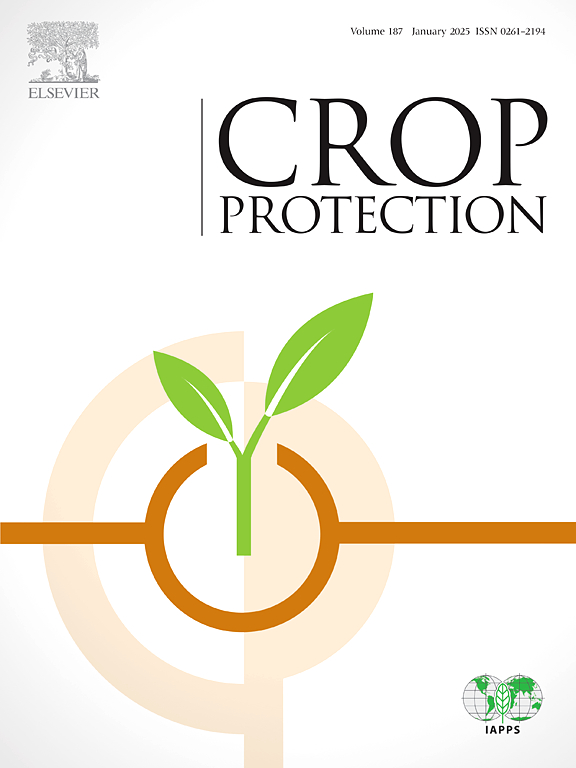番茄紫孢菌的敏感性。巴西对杀菌剂的分离
IF 2.5
2区 农林科学
Q1 AGRONOMY
引用次数: 0
摘要
使用合成杀菌剂进行病害管理是番茄种植者预防番茄紫斑病(SLS)减产的主要策略。尽管这种植物病害很重要,但关于番茄赤霉素分离株对杀菌剂的敏感性的信息很少。采用杀菌剂修饰的96孔微滴板对94株番茄葡萄球菌对氮唑菌酯、百菌清、戊唑唑和甲基硫代菌酯的敏感性进行了测定。在100 mg/L以上,氮唑菌酯、甲基硫代菌酯和戊康唑的ec50值最高。在此基础上,选择5个对每种杀菌剂有抗性和敏感的菌株进行实验。在三个温室试验中,分别用敏感(S)和抗性(R)菌株接种番茄植株,并喷洒杀菌剂。喷施与未喷施杀菌剂的番茄植株,在Septoria叶斑病进展曲线下面积(AUDPC)值、病害严重程度进展和进展率上差异不显著。接种S和R菌株和百菌清、戊唑唑和甲基硫代菌处理的AUDPC值分别为10 ~ 320、0 ~ 80和50 ~ 150。用S和R菌株接种植物时,偶氮菌酯酶的AUDPC值在200左右。有证据表明,在巴西人群中,番茄葡萄球菌个体对氮唑菌酯、戊唑唑和甲基硫代菌酯的敏感性降低。因此,番茄种植者应轮作和组合使用不同作用机制和低抗性风险的杀菌剂来防治SLS。本文章由计算机程序翻译,如有差异,请以英文原文为准。
Sensitivity of Septoria lycopersici Speg. Isolates to fungicides in Brazil
Disease management using synthetic fungicides is the main strategy used by tomato growers to prevent tomato yield reductions caused by Septoria leaf spot (SLS). Despite the importance of this plant disease, there is little information about the sensitivity of Septoria lycopersici isolates to fungicides. The sensitivity of 94 isolates of S. lycopersici to azoxystrobin, chlorothalonil, tebuconazole, and thiophanate-methyl was assessed in experiments using fungicide-amended 96-well microtiter plates. The highest EC 50 values above 100 mg/L were detected for azoxystrobin, thiophanate-methyl, and tebuconazole. Based on these results, five isolates classified as resistant and five as sensitive to each fungicide were selected for the experiments. Tomato plants were inoculated with sensitive (S) and resistant (R) isolates and sprayed by the fungicides in three greenhouse assays. The differences in the values of the area under the progress curve of Septoria leaf spot (AUDPC), disease severity progress, and progress rates were not so pronounced between tomato plants sprayed and non-sprayed with fungicides. The AUDPC values for plants inoculated with S and R isolates and treated with chlorothalonil, tebuconazole, and thiophanate-methyl ranged from 10 to 320, 0 to 80, and 50 to 150, respectively. For azoxystrobin, the AUDPC values were around 200 in plants inoculated with S and R isolates. There is evidence of reduced sensitivity of individuals of S. lycopersici to azoxystrobin, tebuconazole, and thiophanate-methyl in the population in Brazil. Therefore, tomato growers should rotate and combine fungicides with different mechanisms of action and low-risk of resistance to control SLS.
求助全文
通过发布文献求助,成功后即可免费获取论文全文。
去求助
来源期刊

Crop Protection
农林科学-农艺学
CiteScore
6.10
自引率
3.60%
发文量
200
审稿时长
29 days
期刊介绍:
The Editors of Crop Protection especially welcome papers describing an interdisciplinary approach showing how different control strategies can be integrated into practical pest management programs, covering high and low input agricultural systems worldwide. Crop Protection particularly emphasizes the practical aspects of control in the field and for protected crops, and includes work which may lead in the near future to more effective control. The journal does not duplicate the many existing excellent biological science journals, which deal mainly with the more fundamental aspects of plant pathology, applied zoology and weed science. Crop Protection covers all practical aspects of pest, disease and weed control, including the following topics:
-Abiotic damage-
Agronomic control methods-
Assessment of pest and disease damage-
Molecular methods for the detection and assessment of pests and diseases-
Biological control-
Biorational pesticides-
Control of animal pests of world crops-
Control of diseases of crop plants caused by microorganisms-
Control of weeds and integrated management-
Economic considerations-
Effects of plant growth regulators-
Environmental benefits of reduced pesticide use-
Environmental effects of pesticides-
Epidemiology of pests and diseases in relation to control-
GM Crops, and genetic engineering applications-
Importance and control of postharvest crop losses-
Integrated control-
Interrelationships and compatibility among different control strategies-
Invasive species as they relate to implications for crop protection-
Pesticide application methods-
Pest management-
Phytobiomes for pest and disease control-
Resistance management-
Sampling and monitoring schemes for diseases, nematodes, pests and weeds.
 求助内容:
求助内容: 应助结果提醒方式:
应助结果提醒方式:


